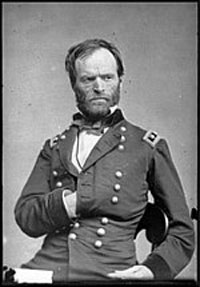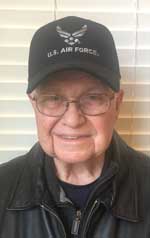The Legacy of Total War Strategy

Many historians date the Atlanta campaign from late April 1864 to September 2, 1864. The September 2 date, however, only marks the withdrawal of General Hood’s Confederate forces from Jonesboro and the official surrender by Atlanta Mayor, James Calhoun. That leaves out an important part of the history. It was not until November 12 that Sherman destroyed Atlanta by ordering all buildings except homes and churches to be burned. Many homes and churches, however, were caught up in the conflagration.
Union forces had begun to probe Confederate strength south of Ringgold, Georgia on April 24 with the objective of a major advance on Atlanta, an important Confederate railroad center and supply depot. Up until the middle of May, General Joe Wheeler’s Confederate cavalry were able to frustrate Sherman’s enormous army of over 100,000 men attempting to advance toward Atlanta.
After a two-day battle at Resaca, Georgia on May 14 and 15, Sherman’s overwhelming numbers forced General Johnston’s Army of Tennessee to withdraw. Sherman’s better than two to one numerical superiority constantly threatened Johnston with flanking or encirclement. Johnston’s Army, however, was able to inflict some stinging defeats on Sherman at Pickett’s Mill in late May and at Kennesaw Mountain from June 19 to 27. Union forces suffered 3,000 casualties at Kennesaw against 1,000 for the Confederates, commanded by Joe Johnston and supported by Confederate infantry corps under William J. “Old Reliable” Hardy, John B. Hood, and Leonidas Polk, and cavalry under Joe Wheeler, totaling about 50,000 men. Union General McPherson’s flanking movements, however, forced Johnston to withdraw to Smyrna.
On July 17, President Davis, frustrated with Johnston’s defensive caution and continued withdrawals, replaced Johnston with John B. Hood. On July 21, after repulsing Hood at Peachtree Creek the previous day, Sherman was in position to bombard downtown Atlanta with artillery. A fierce battle occurred the next day on July 22 that cost the Confederates about 8,500 casualties. This is the date usually given for the Battle of Atlanta. Union General McPherson was killed on that day. However, the Confederates did not withdraw as Sherman had expected.
Sherman then sent General George Stoneman for a cavalry raid on Macon in an attempt to cut Hood’s main southern supply line. He was supported by cavalry divisions under Garrard just southeast of Atlanta and McCook swinging to the south from Newnan southwest of Atlanta. A total of 9,000 Union cavalry pressed to cut off Hood from the major supply depot at Macon.
When Stoneman’s cavalry arrived in front of Macon, however, they met unexpectedly fierce resistance by Confederate militia, composed mostly of older men, disabled veterans, and young boys, commanded by politician-General Howell Cobb. This resistance and the delay it caused may have seemed at first a mere nuisance to Stoneman, but it was a nuisance that contributed to a completely unexpected tactical outcome. Neither did Stoneman anticipate the sheer audacity, speed, and fighting spirit of Confederate cavalry forces opposing him. Hood’s cavalry commander, the young, serious-minded and normally soft-spoken Joe Wheeler, was not inappropriately nicknamed “Fightin’ Joe.”
On July 29-30, Wheeler’s Cavalry force of 5,000 men dealt Sherman’s three divisions of cavalry with 9,000 men a series of stunning defeats. Wheeler routed Sherman’s cavalry at three different points. He mauled and defeated McCook at Newnan. He routed and captured Stoneman and five of his Brigadier generals at Macon and turned Garrard to flight northeast of Atlanta. In all, the Confederates took 3,200 prisoners and numerous supply wagons and artillery batteries. This was the worst and most disastrous defeat ever inflicted on Union cavalry during the entire war.
Unfortunately, the overwhelming manpower resources of the Union would be able to replace Sherman’s losses within months and supply them down to the last tent peg. In August, Hood ordered Wheeler to take 2,000 cavalry on a raid into central Tennessee. This reduction of Confederate cavalry in the Atlanta area had the unfortunate effect of leaving Hood unable to gather intelligence effectively or to successfully hinder the build-up of Union forces around the city. By August 30, Sherman’s forces were in position to cut off the last railroad supply line to Atlanta at Jonesboro.
From August 30 to September 1, Hardee’s Corps with portions of Stephen D. Lee’s Corp and elements of Wheeler’s cavalry attempted to parry a death blow to the strategic city of Atlanta by defending the remaining railroad connection between that city and Macon to the south. This valiant effort was against odds of nearly three to one. On September 2, General Hood was forced to evacuate Atlanta. Hardee had succeeded; however, in delaying Jonesboro’s capture long enough to allow for Hood’s orderly retreat to Lovejoy, Georgia, just south of Jonesboro. Henry Slocum’s Union XX Corp moved into Atlanta and accepted the surrender of the city from Mayor James Calhoun.
Until several years ago, before honoring Confederate dead finally succumbed to ignorant and vicious political correctness, a Confederate Battle Flag flew over Patrick Cleburne Memorial Cemetery near the railroad in Jonesboro, Georgia. The area once marked a Confederate field hospital. The cemetery contains the remains of Confederate soldiers killed at Jonesboro or dying of wounds from other battles around Atlanta. There are several hundred gravestones there, only seven of which can now be identified. It is estimated that a total of 600 to 1,000 Confederate soldiers lie there in either marked graves or mass burials. The Confederates suffered about 2,000 casualties at Jonesboro. Union losses were about 1,100 for the two-day battle.
The Union’s most devastating losses in the Atlanta campaign were suffered in June at Kennesaw Mountain and July 29-30 at the hands of Fighting Joe Wheeler’s cavalry.
On September 4, General Sherman ordered civilian evacuation of Atlanta, much to the protest of Hood and other Confederate leaders. On November 8, Lincoln was reelected President, and on November 12, Atlanta was destroyed by Sherman’s troops.
On November 16, Sherman departed the Atlanta area with his men singing The Battle Hymn of the Republic. His force of 60,000 men proceeded to devastate a 60 mile-wide swath of farms and communities on his march through Georgia to Savannah. Then he turned to destroy 50 percent of the private property in South Carolina, including the burning of Columbia and about a dozen smaller towns.
Sherman was promoted to Lieutenant General after the war and was assigned to command the area West of the Mississippi, which included oversight of railroad progress, prevention of Indian attacks, and negotiating treaties with Indian tribes. A full-scale war broke out in 1868, and Sherman allowed his chief subordinate, Major General Phillip Sheridan, to use “hard war” tactics to get the Indians under control. “Hard war” tactics against civilians conflict with Christian and modern Geneva Convention principles of war and are no longer U.S. policy.
When Ulysses S. Grant became President in March 1969, Sherman succeeded Grant as Commanding General of the United States Army and served in that capacity under presidents Grant, Hayes, Garfield, and Arthur until retiring in November 1983. The Republicans sought to run Sherman for President, but his famous reply was:
“If nominated, I will not run; if elected, I will not serve.”
Sherman was a Republican, which really had more to do with tariffs, banking, and industrial subsidies than slavery questions, and he abhorred the idea of secession. However, he was not an abolitionist and did not believe in “Negro equality.” Throughout the war, he declined to employ black troops in his armies. He had the confidence of Lincoln and Grant but was an enemy of Secretary of War Edwin Stanton. Sherman is probably most famous for his philosophy of “hard war” or “total war” that waged war on Southern civilians, their farms, and their properties to break Southern morale and force Confederate surrender quickly. Two Sherman quotes explain this best:
“War is cruelty. There is no use trying to reform it. The crueler it is, the sooner it will be over.”
“This war differs from other wars, in this particular. We are not fighting armies but a hostile people, and must make old and young, rich and poor, feel the hard hand of war.”
But Sherman’s most famous quote came from a June 19, 1879, address to graduating cadets at the Michigan Military Academy. Describing the ugly reality of war, he warned: “War is hell.”
Lincoln, Grant, and especially Stanton were strong backers of the “hard war” route to Union victory. However, while, Lincoln, Grant, and Sherman favored “hard war” to bring the South to its knees quickly, Stanton wanted to prolong the war to completely smash Southern culture. Many of Stanton’s goals were accomplished by Republican Reconstruction policies governing the South from 1865 through 1877. However, by an odd twist of fate, modern radical reconstructionist ideology and worse is now owned by the Democrats in the form of Critical Race Theory and other forms of government and social coercion.
On April 20, 1865, the last major Confederate surrender of the war, however, Sherman offered Confederate General Joe Johnston liberal surrender terms similar to Grant’s terms to Robert E. Lee on April 9 at Appomattox Courthouse in Virginia. Secretary Stanton, however, leaked to the New York Times that Sherman’s easy terms might have been the result of bribery. Sherman was outraged, but Grant tightened the terms to purely military issues, and Johnston signed them on April 26. This surrender in Durham, North Carolina, was the largest surrender of troops in the war.
Sherman openly objected to the harsh terms and conduct of Reconstruction, and thus many Southerners softened their opinion of him.
One of Sherman’s three brothers was Republican Senator John Sherman of Ohio, who served in U.S. Senate on-and-off from 1861 to 1897 and held several Presidential Cabinet positions as well. John Sherman is most famous for the Sherman Anti-Trust Act of 1890.
The M4 Sherman tank, the most used medium U.S. Army tank In World War II, was named for William Tecumseh Sherman. Born in Lancaster, Ohio, in 1820, Sherman died in New York City on February 14, 1891.









 Mike Scruggs is the author of two books: The Un-Civil War: Shattering the Historical Myths; and Lessons from the Vietnam War: Truths the Media Never Told You, and over 600 articles on military history, national security, intelligent design, genealogical genetics, immigration, current political affairs, Islam, and the Middle East.
Mike Scruggs is the author of two books: The Un-Civil War: Shattering the Historical Myths; and Lessons from the Vietnam War: Truths the Media Never Told You, and over 600 articles on military history, national security, intelligent design, genealogical genetics, immigration, current political affairs, Islam, and the Middle East. 



